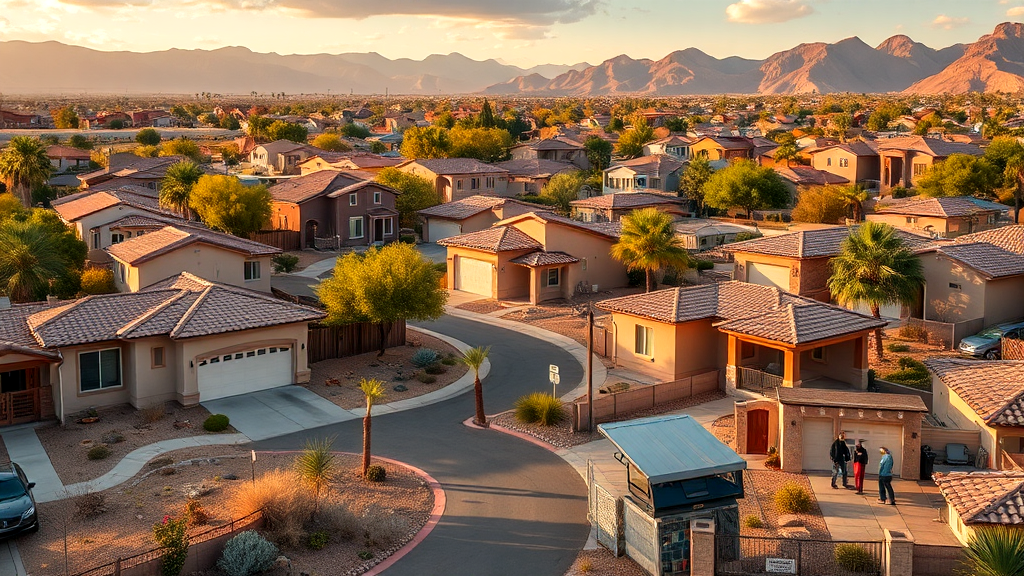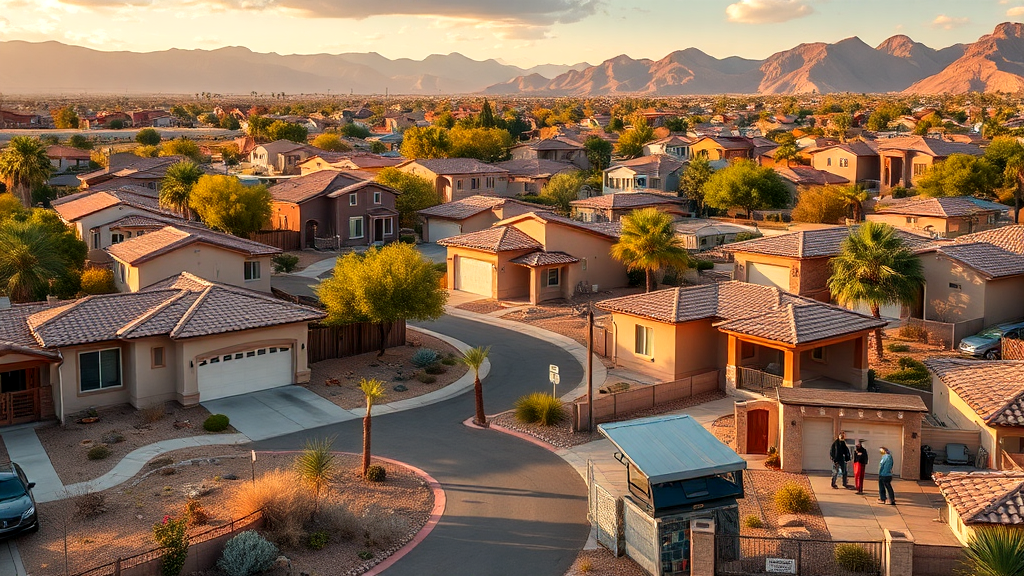Analyzing Current Housing Market Data
Exploring the current Arizona housing market reveals dynamic shifts and intriguing patterns. Home prices are on the rise, with the median price at $434,865, showcasing a 4.3% increase from last year. This growth highlights the persistent demand in the real estate arena, though affordability remains a hurdle. Many find themselves drawn to the rental market, driven by rising prices and wage concerns.
In terms of market trends, sales volume has decreased by 6.2%, with homes lingering longer before selling. This could signal a cooling interest, possibly linked to higher mortgage rates. The sale-to-list price ratio rests at 98.9, hinting at a balanced yet evolving market.
Inventory levels are climbing, offering buyers more options and potentially stabilizing prices. Yet, past underbuilding keeps pressure on the supply side. The Arizona market analysis suggests a gradual shift toward balance, driven by these factors.
Real estate agents are observing a robust real estate market, despite challenges like water scarcity. With population growth and migration fueling demand, housing market predictions remain optimistic. The national association views these dynamics as key to understanding the current Arizona market.
Home Prices and Affordability
Considering the increasing home prices in Arizona, affordability is becoming a hot potato for many. The Arizona housing market has seen prices climb to a median of $434,865, a 4.3% uptick from last year. Buyers in regions like Coconino County face even steeper climbs, with prices hitting $725K. This leaves potential homeowners scratching their heads, as wage growth struggles to keep pace. Now, people are turning to rentals, where the cost for a two-bedroom apartment is $1,097.
The real estate market is also seeing shifts in dynamics. While the current Arizona market presents challenges, there’s hope for more balanced conditions soon. For those pondering affordability woes, the National Low Income Housing Coalition offers a detailed outlook here.
With changes in mortgage rates and economic conditions, housing market trends remain an ever-present topic of discussion. The National Association keeps a keen eye on these fluctuations, helping real estate agents adapt strategies. As inventories rise, eyes are peeled for potential price stabilization. How this will impact Arizona real estate and the broader housing market remains a cliffhanger, as experts weigh in on future predictions.

Sales Volume and Market Dynamics
Examining the sales volume and evolving market conditions in Arizona reveals fascinating insights. The Arizona housing market has seen a 6.2% decrease in sales volume year-over-year, reflecting a possible slowdown. Homes linger longer on the market, averaging 51 days, which suggests a shift in buyer interest due to increased home pricesand high mortgage rates. The sale-to-list price ratio hovers around 98.9, signaling an equilibrium but hinting at more room for negotiation as inventory levels rise.
With more homes for sale, buyers might finally catch a break in this tug-of-war. However, the state’s real estate market is facing an interesting conundrum. Years of building fewer homes have left a lasting shortage, keeping prices elevated. Meanwhile, the National Association keeps tabs on how these trends play out in the Arizona real estatescene. As this unfolds, housing market predictions suggest a gradual balancing act.
A word to the wise: real estate agents might want to polish their negotiation skills. The Arizona market analysis underscores the changing tides that might redefine this dynamic arena. As mortgage rates stabilize, buyers could regain some control.
Inventory Levels and Housing Supply
Examining the current Arizona housing market reveals intriguing shifts. Arizona’s inventory levels are expanding, offering more choices for homebuyers. This increase could cool off home prices, making it slightly easier for those on the hunt.
But, don’t throw confetti just yet. Years of underbuilding have left the market in a pickle, keeping overall supply tight. It’s like trying to fill a bathtub with a teaspoon. Buyers might have more options now, but that doesn’t mean they’re swimming in them.
Real estate agents might find themselves juggling more listings, but the balancing act is delicate. More homes on the market could mean more competition, and sellers may need to polish their curb appeal. Buyers could have more room to haggle, especially with those pesky mortgage rates still in the picture.
The National Association is keenly watching these developments, expecting prices to stabilize. For now, the Arizona real estate scene is a chess game, with each move crucial. If you’re in the market, keep your eyes peeled for any sudden changes!

Economic Factors Influencing the Market
Economic factors tugging at the market cover a range of influences. The Arizona housing market dances to the rhythm of population growth, with newcomers drawn by sunny skies and jobs. This influx keeps demand high, even as housing supply struggles to keep tempo. Meanwhile, home prices shimmy upwards, nudging many towards renting.
What about those pesky mortgage rates? They’re like the unpredictable beat in a song, keeping buyers on their toes. While they’re holding steady above 6%, a dip could boost buyer enthusiasm. The National Association keeps a watchful eye, predicting stability but no sudden leaps.
Economic growth in Arizona, fueled by tech and healthcare, adds a strong bass line to the housing scene. Yet, water scarcity could hit a sour note, impacting long-term growth. As for housing market trends, they suggest a shift towards a balanced market. With more homes on the dance floor, buyers might gain negotiating power. For a deeper dive into trends, Realtor’s overview of Arizona offers insights: Realtor’s Arizona Overview.
Impact of Population Growth and Migration
Arizona’s growth spurt, fueled by population surges and migration, is shaking things up. As more people pack their bags for the Grand Canyon State, the Arizona housing market feels the heat. This influx keeps the demand high, pushing home prices upward. It’s like trying to squeeze an elephant into a Volkswagen—something’s got to give!
But there’s more to this tale. As the Arizona real estate scene faces this tidal wave of newcomers, it also grapples with a limited supply. More people, fewer homes—a recipe for higher prices, or perhaps more crowded neighbors. Yet, the National Association watches closely, hoping for balance.
Meanwhile, the buzz around housing market trends continues. Some whisper of a slow shift, a gentle nudge toward equilibrium. Could buyers finally get a leg up? With more homes making appearances, perhaps negotiations will swing in their favor. Still, the market remains competitive, a high-stakes poker game with no clear winner. As we watch this unfold, one can’t help but wonder what’s next for Arizona.
Role of Economic Development in Real Estate
The role of economic growth in shaping property dynamics is undeniable. Arizona’s booming sectors—technology, healthcare, and tourism—act as a magnet, drawing people and investments. This prosperity fuels housing market trends, making properties more valuable. However, it’s like balancing on a seesaw. While economic growth boosts demand and home prices, it also highlights challenges like water scarcity and climate risks. These factors might put a damper on long-term property values.
Here are a few things that economic growth in Arizona could influence:
-
Job Creation: More jobs mean more people moving in, increasing housing demand.
-
Infrastructure Investments: Roads and services improve, making areas more attractive.
-
Income Levels: Higher wages can make homes more affordable for locals.
-
Migration Patterns: Newcomers bring diversity, impacting neighborhood dynamics.
-
Environmental Concerns: Growth might strain resources, affecting future development.
-
Property Value Stability: Economic growth can lead to stable or rising property values.
-
National Association Involvement: They monitor shifts, offering guidance to stakeholders.
Economic development is the engine driving change, but it requires careful management to ensure sustainable growth for Arizona’s housing scene.
Predictions for Arizona Housing Market
Forecasting the future of Arizona’s home prices involves looking at current trends. Experts see a steady climb in prices through 2024, driven by the state’s continued demand and limited inventory. High mortgage rates might keep some buyers on the sidelines, but no major downturn is expected. Picture a dance, where the market moves towards balance, creating opportunities for both buyers and sellers.
The anticipation is that mortgage rates will stabilize, possibly encouraging more activity. If these rates dip, we could see a lively resurgence in buyer interest.
Could Arizona tip the scales to a buyer’s market? While predominantly a seller’s playground, the increase in available homes suggests a shift. In areas with notable inventory growth, buyers might gain the upper hand. Yet, demand remains strong, keeping competition alive.
Navigating this market requires considering more than just numbers. Economic factors, population growth, and even climate play roles in shaping the scene. As the state grows, both challenges and opportunities emerge, influencing future dynamics. Who knows what changes the next year might bring?

Expert Opinions on Market Trends
Expert views on current shifts suggest steady home price growth through 2024. With robust demand and limited inventory, prices are climbing like a hiker up Camelback Mountain. Despite high mortgage rates, the market stays competitive.
Buyers might hesitate, but experts foresee no crash on the horizon. There’s a chance for a more balanced scenario, giving buyers and sellers opportunities. Slow shifts are seen toward negotiation power for buyers, potentially balancing the scales.
Like a desert sunset, changes in mortgage rates may bring warmth to the market. Predictions of rate stabilization could entice more buyers. If rates dip, expect increased activity.
Arizona’s popularity for newcomers acts like a magnet, pulling in folks with dreams of a sunlit lifestyle. Migration fuels demand, yet strains supply.
Economic influences range from tech booms to water worries. These elements shape the future, offering both growth and challenges. As the state evolves, housing dynamics will adapt. Keep an eye out for unexpected twists and turns that the next year might reveal.
Anticipated Changes in Mortgage Rates
The anticipated fluctuations in borrowing costs captivate those eyeing the Arizona property scene. Presently hovering above 6%, these rates might ease, inviting potential buyers to reconsider their options. A slight dip could act as a catalyst, reviving interest and transactions in the area.
Picture a seesaw: the lower the rates, the higher the interest from buyers. With the current elevated rates, some folks are playing the waiting game, hoping for a drop. But who knows? The unpredictable nature of economic shifts keeps everyone guessing.
Despite the current challenges, there’s an undercurrent of optimism. Some experts hint at steady rates, which could mean smoother sailing for those looking to invest. This stability might not just benefit buyers; sellers could find a more predictable environment too.
As the region transitions, the future holds a mix of opportunities and hurdles. For more insights into this trend, Olson Homebuyers provides valuable perspectives. Expect a lively dance of offers, counteroffers, and strategic moves as buyers and sellers find their footing in this evolving scenario.
Will Arizona Shift to a Buyer’s Market?
The big question on everyone’s mind: Will Arizona be leaning towards being a buyer’s paradise? There are whispers of change as home prices show signs of stabilizing. With more homes popping up for sale, buyers might soon feel like kids in a candy store. However, it’s not all sunshine and rainbows. The cost of living is still a mountain to climb, especially in areas like Coconino County. This could keep some folks renting rather than buying.
A fascinating twist is how long homes sit on the market. They’re taking their sweet time, averaging 51 days to find a new owner. This could mean buyers have more room to negotiate. In some spots, the scales might tip in favor of the buyer. But don’t pop the champagne just yet! Arizona’s allure brings in new residents like bees to honey, keeping demand buzzing.
While the current climate suggests a slow waltz towards a balanced market, the dance is far from over.
Conclusion
Arizona’s housing market stands at a crossroads, teetering between a seller’s stronghold and a buyer’s haven. The rise in home inventory offers hope to prospective buyers. Yet, affordability challenges persist, especially with high mortgage rates. Buyers might soon find themselves in a more favorable position as prices stabilize and choices increase.
Economic factors play a pivotal role. Arizona’s booming industries and population growth fuel demand. However, issues like water scarcity could impact long-term prospects. As we move forward, keeping an eye on market trendsand expert predictions will be key. Arizona’s housing scene remains vibrant, and it promises to be an exciting journey to watch unfold.
FAQ
-
What are the current trends in Arizona’s home prices and affordability?
Home prices in Arizona have risen, with a median price around $434,865. This is a 4.3% increase from last year. Affordability is a big concern, especially in areas like Coconino County, where prices hit $725K. Many people are turning to rentals as the cost of living outpaces wage growth.
-
How has the sales volume in Arizona been affected recently?
Sales volume has dropped by 6.2% compared to last year. Homes now take about 51 days to sell. This indicates a cooling in buyer interest, possibly due to higher prices and mortgage rates. The sale-to-list price ratio is at 98.9, showing a balanced market but hinting at possible shifts.
-
What impact does population growth and migration have on Arizona’s housing market?
Arizona continues to attract new residents, drawn by its climate and job prospects. This growth, especially in Phoenix, keeps housing demand high. However, it also puts pressure on housing supply and infrastructure, challenging the market balance.
-
How might economic development influence Arizona’s real estate market?
The state’s economy, driven by tech, healthcare, and tourism, supports the housing market. Investments in infrastructure enhance property values and stability. Yet, challenges like water scarcity and climate risks could affect long-term growth.
-
Is Arizona’s housing market expected to shift to a buyer’s market soon?
Currently, Arizona is mainly a seller’s market. But increased inventory and stable prices suggest a shift toward balance. Buyers may gain more power in regions with inventory growth. However, the market stays competitive due to ongoing demand and economic factors.


 Facebook
Facebook
 X
X
 Pinterest
Pinterest
 Copy Link
Copy Link

